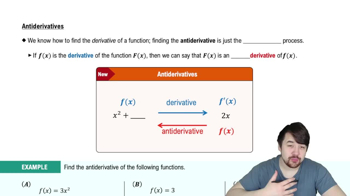Let , where is the function whose graph is shown. Which of the following statements is true about ?
Table of contents
- 0. Functions7h 54m
- Introduction to Functions16m
- Piecewise Functions10m
- Properties of Functions9m
- Common Functions1h 8m
- Transformations5m
- Combining Functions27m
- Exponent rules32m
- Exponential Functions28m
- Logarithmic Functions24m
- Properties of Logarithms36m
- Exponential & Logarithmic Equations35m
- Introduction to Trigonometric Functions38m
- Graphs of Trigonometric Functions44m
- Trigonometric Identities47m
- Inverse Trigonometric Functions48m
- 1. Limits and Continuity2h 2m
- 2. Intro to Derivatives1h 33m
- 3. Techniques of Differentiation3h 18m
- 4. Applications of Derivatives2h 38m
- 5. Graphical Applications of Derivatives6h 2m
- 6. Derivatives of Inverse, Exponential, & Logarithmic Functions2h 37m
- 7. Antiderivatives & Indefinite Integrals1h 26m
- 8. Definite Integrals4h 44m
- 9. Graphical Applications of Integrals2h 27m
- 10. Physics Applications of Integrals 3h 16m
- 11. Integrals of Inverse, Exponential, & Logarithmic Functions2h 34m
- 12. Techniques of Integration7h 41m
- 13. Intro to Differential Equations2h 55m
- 14. Sequences & Series5h 36m
- 15. Power Series2h 19m
- 16. Parametric Equations & Polar Coordinates7h 58m
8. Definite Integrals
Fundamental Theorem of Calculus
Problem 5.3.39
Textbook Question
Definite integrals Evaluate the following integrals using the Fundamental Theorem of Calculus
∫¹₁/₂ (t⁻³ ― 8) dt
 Verified step by step guidance
Verified step by step guidance1
Step 1: Identify the integral to be evaluated: ∫1/21 (t⁻³ − 8) dt. This is a definite integral, meaning we will evaluate it over the interval [1/2, 1].
Step 2: Break the integral into two parts for clarity: ∫1/21 t⁻³ dt − ∫1/21 8 dt. This uses the property of linearity of integrals.
Step 3: Use the Fundamental Theorem of Calculus to find the antiderivative of each term. For t⁻³, the antiderivative is . For the constant 8, the antiderivative is 8t.
Step 4: Apply the limits of integration [1/2, 1] to each antiderivative. For the first term, evaluate at t = 1 and t = 1/2, and subtract the results. For the second term, evaluate 8t at t = 1 and t = 1/2, and subtract the results.
Step 5: Combine the results from both parts to get the final value of the definite integral. Simplify the expressions as needed.
 Verified video answer for a similar problem:
Verified video answer for a similar problem:This video solution was recommended by our tutors as helpful for the problem above
Video duration:
4mPlay a video:
Was this helpful?
Key Concepts
Here are the essential concepts you must grasp in order to answer the question correctly.
Definite Integrals
Definite integrals represent the signed area under a curve defined by a function over a specific interval. They are calculated using the limits of integration, which specify the range over which the area is computed. The result of a definite integral is a numerical value that reflects this area, and it is denoted as ∫[a, b] f(t) dt, where [a, b] are the limits of integration.
Recommended video:

Definition of the Definite Integral
Fundamental Theorem of Calculus
The Fundamental Theorem of Calculus links the concept of differentiation with integration, providing a method to evaluate definite integrals. It states that if F is an antiderivative of f on an interval [a, b], then ∫[a, b] f(t) dt = F(b) - F(a). This theorem allows us to compute the value of a definite integral by finding the antiderivative of the integrand and evaluating it at the boundaries.
Recommended video:

Fundamental Theorem of Calculus Part 1
Antiderivatives
An antiderivative of a function f(t) is another function F(t) such that F'(t) = f(t). Finding antiderivatives is essential for applying the Fundamental Theorem of Calculus, as it allows us to determine the area under the curve represented by f(t). Common techniques for finding antiderivatives include power rule, substitution, and integration by parts, depending on the complexity of the function.
Recommended video:

Antiderivatives

 6:11m
6:11mWatch next
Master Fundamental Theorem of Calculus Part 1 with a bite sized video explanation from Patrick
Start learningRelated Videos
Related Practice
Multiple Choice
41
views
